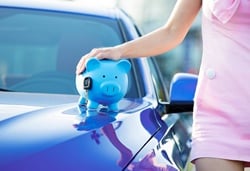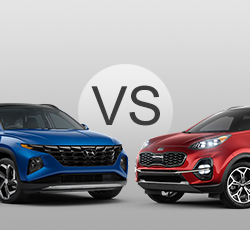2021 Hyundai Tucson vs Kia Sportage
Customers in the market seek affordable and practical SUVs that aren't too big or bulky. The Hyundai Tucson and Kia Sportage both fit this bill perfectly; both brands being very similar; in fact, Hyundai owns a share in Kia Motors. Thus, it's no surprise why these two SUVs have become so popular amongst those seeking compact SUVs at an excellent value.
In this guide, the two models will be compared in various aspects to give prospective customers a better idea of which would suit their needs.
The Powertrain
For the thrill seekers out there, Kia has two models tailor-made to meet your needs: Tucson and Sportage. Offering up impressive power with either a 2.0 liter or larger 2.4 engine that boasts 181 horsepower and if you need an extra burst of speed opt for SX Turbo trims – they’ll provide an eye-popping 240 horses.
Both vehicles feature front/all wheel drive systems as well as six-speed automatic transmissions, so no matter where the road may take you just know these SUVs are ready for anything life can throw at them; from moderate towing loads (up to 2000 lbs in certain areas) - perfect for transporting cargo - all the way up to those heart racing curves on winding mountain roads.
Most people looking at vehicles in this class are concerned with fuel economy. Unfortunately, neither vehicle delivers particularly impressive numbers in this regard - the Tucson can earn up to 28 miles per gallon on the highway and 23 in the city, while the Sportage does a bit better at 30 mpg on the highway and 23 in the city. These figures are adequate but nothing to get too excited about.
Drivability
The Tucson and Sportage are both easy to drive. Their smaller engines don't get too loud, which is good since there aren't any special noise-cancelling features in these SUVs. All available engines won't wow anyone with how fast or responsive they are, but they'll get the job done without issue.
These models boast impressive versatility, featuring 60/40 split rear seats that allow people to lower one side or fold down the entire row. In the Tucson model, for instance, the cargo area measures 31 cubic feet but can be expanded up to almost 62 cubic feet when all seats are folded down.
By now, it should not come as a shock that the Sportage boasts similar storage space figures. With 30.7 cubic feet when the rear seats are up and 60.1 cubic feet when they're folded down, this crossover offers ample versatility.
Both Tucson and Sportage are two-row SUVs that comfortably seat five people. Both trims offer identical legroom measurements - 41.5 inches in the front row and 38.2 inches in the second row - which will come in handy during longer road trips when your cabin is full of passengers.
Drivers appreciate the open cabins of modern vehicles, which allow them to see everything around their vehicles. A large window in the back provides a clear line of vision when backing up.
It is essential to review the technology packages that each of these vehicles offers. In the Tucson, the standard touchscreen measures seven inches with Android Auto, Apple CarPlay, a six-speaker sound system, Bluetooth connectivity, and steering-wheel mounted controls. Moving up from entry-level SE gives customers SiriusXM, HD Radio, Blue Link Connected Car System - which lets people use their smartphones remotely start engines, unlock doors or check on vehicle diagnostics - plus eight-inch touchscreens with navigation systems, wireless charging capabilities and Infinity Audio sound systems are standard on higher trims of this luxury sedan.
The Sportage boasts an advantage over the Hyundai Tucson in that every trim comes with an eight-inch touchscreen display - giving it a clear advantage. Plus, every package comes standard with Apple CarPlay, Android Auto, Bluetooth and Siri Eyes Free for voice commands. SiriusXM is only available on certain mid-level trims while being standard on the highest trim along with navigation software and Harman Kardon premium sound system - rivalling what the Tucson offers.
To avoid overpaying on a new car, shop prices online first. Get up front pricing before you walk into a dealership. We recommend the following free services; Car Clearance Deals, NADAguides, CarsDirect & & Motortrend.
These free services will offer you the lowest prices and supply you with multiple competing price quotes. You will know the best price before you visit the dealer.
Safety
When considering these vehicles from a safety perspective, there are many similarities between them, as both boast numerous advanced features.
However, the Sportage may offer slightly more than the Tucson does. For instance, it comes standard with pedestrian detection - a feature only available on higher trims of the Tucson. Furthermore, its base model has available blind spot and rear cross traffic monitoring which aren't included on entry-level trims of the Hyundai Tucson.
Smart cruise control, a system in which a vehicle can adjust its speed to maintain a safe distance from other vehicles, is only available on the top-tier Tucson trims. In comparison, it's standard across all Sportage trims except the highest one which comes standard.
Comparing the two models, most other features remain virtually identical: vehicle stability control, anti-lock brakes, multiple air bags and three-point seat belts in every position.
There is one notable distinction, however: only the Kia Sportage offers Hill Start Assist Control. When stopped on a hill and pressure is taken off the brake pedal for about a second, those brakes will be held for some time until pressure is taken off of them - helping prevent rolling backwards of your Kia. This feature comes in handy when someone needs time to transfer pressure onto the gas pedal at stop signs or stop lights.
Which Offers the Best Value?
When compared to other SUVs, the Hyundai Tucson and Kia Sportage are both offered at great value - starting prices of $23,700 and $24,090 respectively. But there's more than just a difference in price points. The higher-end model of Kia Sportage comes with four trim levels offering additional features like an eight-inch touchscreen display on the LX level model or Sofino synthetic leather interior upholstery for those who opt for S trims plus heating side mirrors with LED turn signals as well as fog lights . No matter which you choose though it offers great affordability AND luxury!
The top two Sportage trims are the EX ($27,390) and SX Turbo ($33,750). Both feature power liftgates, smart key entry, dual-zone climate control, heated front seats, and power-adjustable driver's seats. The SX Turbo takes performance to another level with its more advanced engine and offers ventilation in the front seats as well as leather upholstery, heated steering wheel, panoramic sunroof, sporty accents and parking assist.
The Hyundai Tucson lineup offers a variety of trim levels. As mentioned previously, the entry-level SE trim starts at $23,700 and features seven-inch touchscreen with smartphone compatibility, numerous driver assist mechanisms, and cloth seats. The Value trim comes next at $25,150 and offers power adjustable driver's seat, heated front seats, smart entry (also called Proximity Key entry) and LED exterior accents.
At the middle of the range are the SEL and Sport models. At SEL level, you get dual-zone automatic climate control as well as second row vents; priced at $26,100 more than Value due to its larger engine. In contrast, Sport looks sportier with fog lights, LED headlights, and LED Daytime Running Lights.
Both the Limited and Ultimate look upscale with chrome exterior door handles and window trim moldings, including the panoramic sunroof on the Ultimate. Inside their cabins, leather seats and heated steering wheels add to their upscale atmosphere; furthermore, the Ultimate offers heated rear seats as well as ventilation in the front seats for added comfort. All things considered, both cost $29,400 for the Limited model and $32,050 for the Ultimate.
Which Is Better?
Comparing the 2021 Hyundai Tucson and 2021 Kia Sportage can be tricky due to their similar designs and engine options. Both share a frame, identical dimensions, and even share an available engine; however, one major distinction is that the Sportage offers a turbo engine as its second choice while the Tucson starts out with a small engine. Performance-wise, those who prioritize performance will definitely prefer the Sportage over its smaller counterpart.
From a financial standpoint, there's not much that sets these models apart. Some may appreciate that the Tucson offers more trim levels for customization; even though a one-thousand dollar difference may not seem significant, budget-conscious drivers will notice it and may favor the Tucson.
Finally, the Sportage has a larger touchscreen and more standard driver-assist technologies than the Tucson does, but both vehicles are nicely appointed. The Value trim of the Tucson offers great benefits like heated front seats and power-operated driver's seat - but which SUV offers better overall value?
In the end, customers seeking extra performance may prefer the Sportage over Tucson. On the other hand, those seeking practicality may prefer something like the Tucson. If money is tight, then Tucson should come out on top in this matchup; if not though, then Sportage would be more thrilling for customers to choose from.

Get up to 4 local dealers to compete for your business by offering free, competitive pricing. Know before you go to the dealer.
Every dealer offers a secret price. Find yours here.
• 2021 Hyundai Tucson VS Ford Escape
• 2021 Hyundai Tucson VS Honda CR-V
• 2021 Hyundai Tucson VS Kia Sportage
• 2021 Hyundai Tucson VS Mazda CX-5
• 2021 Hyundai Tucson VS Nissan-Rogue
• 2021 Hyundai Tucson VS Toyota RAV4


